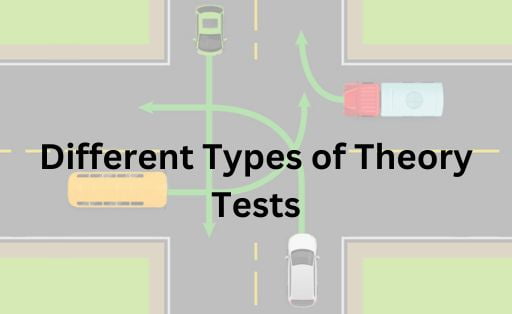Before obtaining a driver’s license or motorcycle endorsement, aspiring drivers and riders must pass a theory test. Theory tests assess your knowledge of road rules, signs, and your ability to recognize and respond to potential hazards. However, not all theory tests are the same. There are various types of theory tests tailored to different categories of vehicles and road users. In this comprehensive guide, we will explore the different types of theory tests, their specific requirements, and their significance in ensuring road safety.
Recommended: Ride Sharing Method is aid in lessening the city Traffic Congestion

Contents
The General Driving Theory Test
The most common type of theory test is the general driving theory test, often taken by those seeking a full car driver’s license. This test is divided into two main sections:
1. Multiple-choice Questions
In this section, candidates answer a series of multiple-choice questions that cover various aspects of road rules, traffic signs, and safe driving practices.
To pass this section, you typically need to score a specified minimum, usually around 43 out of 50 questions.
2. Hazard Perception Test
The hazard perception test assesses your ability to spot potential hazards while driving. It consists of a series of video clips showing various road scenarios.
Candidates are required to click a mouse button or tap a screen when they identify a developing hazard.
Scoring is based on how quickly and accurately candidates respond to hazards.
The pass mark for this section is typically around 44 out of 75.
The Motorcycle Theory Test
Motorcycle riders must pass a specific motorcycle theory test to obtain their motorcycle license. The motorcycle theory test includes the same two sections as the general driving theory test: multiple-choice questions and the hazard perception test.
However, the content of the motorcycle theory test focuses on motorcycle-specific topics, such as proper helmet use, riding gear, safe riding techniques, and the handling of motorcycles in different road conditions. To pass, candidates must score well on both sections.
The Hazard Perception Test
In some regions, including the United Kingdom, you may take the Hazard Perception Test as a standalone test, regardless of the vehicle you intend to drive or ride. This test solely evaluates your hazard perception skills, using video clips to simulate real driving scenarios.
While the Hazard Perception Test can be a separate test, it is also a critical component of both the general driving theory test and the motorcycle theory test. It assesses your ability to anticipate and respond to potential dangers on the road, making it a crucial skill for all road users.
The LGV and PCV Theory Tests
Drivers of large goods vehicles (LGV) and passenger-carrying vehicles (PCV), such as buses and coaches, must pass specialized theory tests. These tests are designed to evaluate knowledge specific to these vehicle categories.
The LGV theory test includes multiple-choice questions and a hazard perception test, similar to the general driving theory test. However, the content focuses on topics relevant to driving LGVs, including vehicle safety, loading procedures, and the transportation of goods.
The PCV theory test follows a similar format, with multiple-choice questions and a hazard perception test. The questions and scenarios are tailored to the operation of passenger-carrying vehicles, emphasizing passenger safety and passenger-related regulations.
Theory Tests for Special Needs
In many regions, including the United Kingdom, accommodations are available for individuals with disabilities or special needs who wish to take theory tests. These accommodations can include:
- Extra time to complete the test.
- A reader or sign language interpreter.
- Voiceovers or translated versions of the test.
- The option to take the test on a computer.
These accommodations ensure that theory tests are accessible to a wide range of candidates, promoting inclusivity and equal opportunities for all road users.
The Importance of Theory Tests
Theory tests serve several critical purposes:
1. Assessing Knowledge
Theory tests evaluate candidates’ knowledge of road rules, traffic signs, and safe driving or riding practices.
This knowledge is fundamental to understanding and following road laws, contributing to safer roads.
2. Testing Hazard Perception
The hazard perception component of theory tests assesses candidates’ ability to recognize and respond to potential dangers.
Developing strong hazard perception skills is essential for avoiding accidents and promoting road safety.
3. Ensuring Compliance
Theory tests ensure that drivers and riders are aware of and compliant with specific regulations and rules related to their vehicle category.
4. Promoting Road Safety
A well-prepared and knowledgeable driver or rider is more likely to make safe and responsible decisions on the road, reducing the risk of accidents.
Conclusion
Understanding the different types of theory tests is essential for aspiring drivers and riders. Whether you’re preparing for a general driving theory test, a motorcycle theory test, or a specialized LGV or PCV theory test, the knowledge and skills assessed in these tests are vital for safe and responsible road use.
Theory tests serve as a foundation for becoming a confident and knowledgeable road user. They not only help you obtain your driver’s license but also equip you with the knowledge and hazard perception skills necessary for a lifetime of safe driving or riding. So, whether you’re on the path to becoming a car driver, motorcyclist, or professional LGV or PCV driver, take your theory test preparation seriously, as it is an integral part of ensuring road safety for yourself and others.
